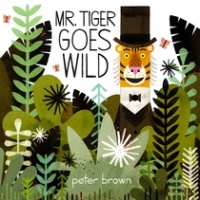A Jaunty Chapeau to a Hawaiian Shirt – Peter Brown’s Mr. Tiger Goes Wild
(The second in my mock Caldecott Award series)
The 2014 Caldecott Award would be best represented by Mr. Tiger Goes Wild by Peter Brown, a story about an anthropomorphized animal who resists his place in civilization.
One outstanding aspect to this book is Brown’s graphic style. The use of limited color palette, swaths of white space, and simple shapes effectively evokes the emotional arc of the protagonist.

The three opening double-spreads are dominated by monochromatic gray-brown illustrations, signaling discontent. Mr. Tiger’s orange fur, pink nose, and bright speech bubbles are the focal point. Brown’s choice to avoid realism in favor of animals made from simple shapes evokes Ed Emberley’s drawing tutorial books. Simple lines on the animal’s faces indicate displeasure or happiness, and the rigidity of the rectangular bodies is a visual reminder of their inflexibility. The use of color to contrast Mr. Tiger and society is most dramatic when his friends banish him to the wilderness (21-22); the exclusive colors are gray for the verso, orange for the recto. In the pages following, the browns of the city are left behind for the greens and blues of the forest, indicating a change in emotion. Indeed, the Tiger initially seems happy to be in the forest, frolicking in the same ways he did when he first began to embrace his wild nature. However, even the forest becomes monotonous, and the green repeated shapes and his reduced size articulates his loneliness. When the rain begins, the forest becomes more tinged with gray, and the linear, vertical shape of the trees echoes the rectangular houses in the city. At the end of the book, when Mr. Tiger has chosen to return to the city, illustrations are more balanced in their use of color and horizontal shapes to show the citizens have achieved more balance in their lives. Ultimately, Mr. Tiger’s desire to subvert the rules of society change his community. Mr. Tiger foregoes the suit and instead wears a floral shirt, the short sleeves showing his stripes. His animal friends occasionally walk on four feet. By the end, other animals join him in the forest, all wearing hats but no clothes, while he wears neither. The shifting color palette and simple shapes then reinforces the deeper message of the book: that the place we live is not so important as expressing one’s true nature.
Mr. Tiger Goes Wild is also an exceptional picture book for its use of humor through illustration. The depiction of proper animals allows readers to see those characters as a proxy for adult humans. The refined nature of those animals is laughable, particularly when the horse says, “Now children, please do not act like wild animals” (4) or when the well-dressed animals shout their surprise out of the windows as Mr. Tiger races across the rooftops (15-16). The tiger himself is a source of humor, from his tongue-in-cheek greeting “Good day, Mr. Deer” (4), to the way he slips off of the page (7-8), to his first moment as a smiling, suit-wearing tiger on all four legs. His humor is highlighted when he embraces his wild side, chasing smaller, top-hat-wearing animals, climbing up a vertical building, sitting on a park bench, the hat finally off, with orange word bubble yelling ROAR! This roar becomes even more amplified when he is in the forest and it is so loud the word extends beyond the speech bubble. The pages most likely to gain a chuckle are those where Mr. Tiger breaks social conventions and goes swimming in a fountain. The humor is amplified with the page turn – he is naked!
Finally, the overall design of the book is outstanding in its commitment to the exploration between civilization and the wild. The end papers reinforce the differences visually: the front papers are grey brick while the back papers are repeating botanical shapes on a muted green background. The cover includes an image of the tiger wearing a top hat, the ultimate high-society chapeau. The back flap of the jacket also delicately underscores the story, a graphic self-portrait of the dapper author stating, “Hello. I am Peter Brown, and it is my professional opinion that everyone should find time to go a little wild.” Finally, the book itself becomes a tiger because if you remove the jacket, the boards are the tiger stripes, oriented as they would be if a tiger were walking in the wild. Mr. Tiger Goes Wild is a remarkable jaunt into the wilderness and back again.
Brown, Peter. Mr. Tiger Goes Wild. New York, NY: Little Brown &, 2013. Print.
